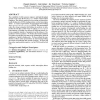96 search results - page 13 / 20 » Motif statistics |
BMCBI
2008
13 years 10 months ago
2008
Background: Amino acid sequence probability distributions, or profiles, have been used successfully to predict secondary structure and local structure in proteins. Profile models ...
MIR
2010
ACM
14 years 4 months ago
2010
ACM
Sparse coding is a key principle that underlies wavelet representation of natural images. In this paper, we explain that the effort of seeking a common wavelet sparse coding of i...
BMCBI
2007
13 years 10 months ago
2007
Background: It is becoming increasingly important for researchers to be able to scan through large genomic regions for transcription factor binding sites or clusters of binding si...
RECOMB
2001
Springer
14 years 10 months ago
2001
Springer
A method is presented that uses b-strand interactions to predict the parallel right-handed b-helix super-secondary structural motif in protein sequences. A program called BetaWrap...
RECOMB
2003
Springer
14 years 10 months ago
2003
Springer
The availability of whole genome sequences and high-throughput genomic assays opens the door for in silico analysis of transcription regulation. This includes methods for discover...

